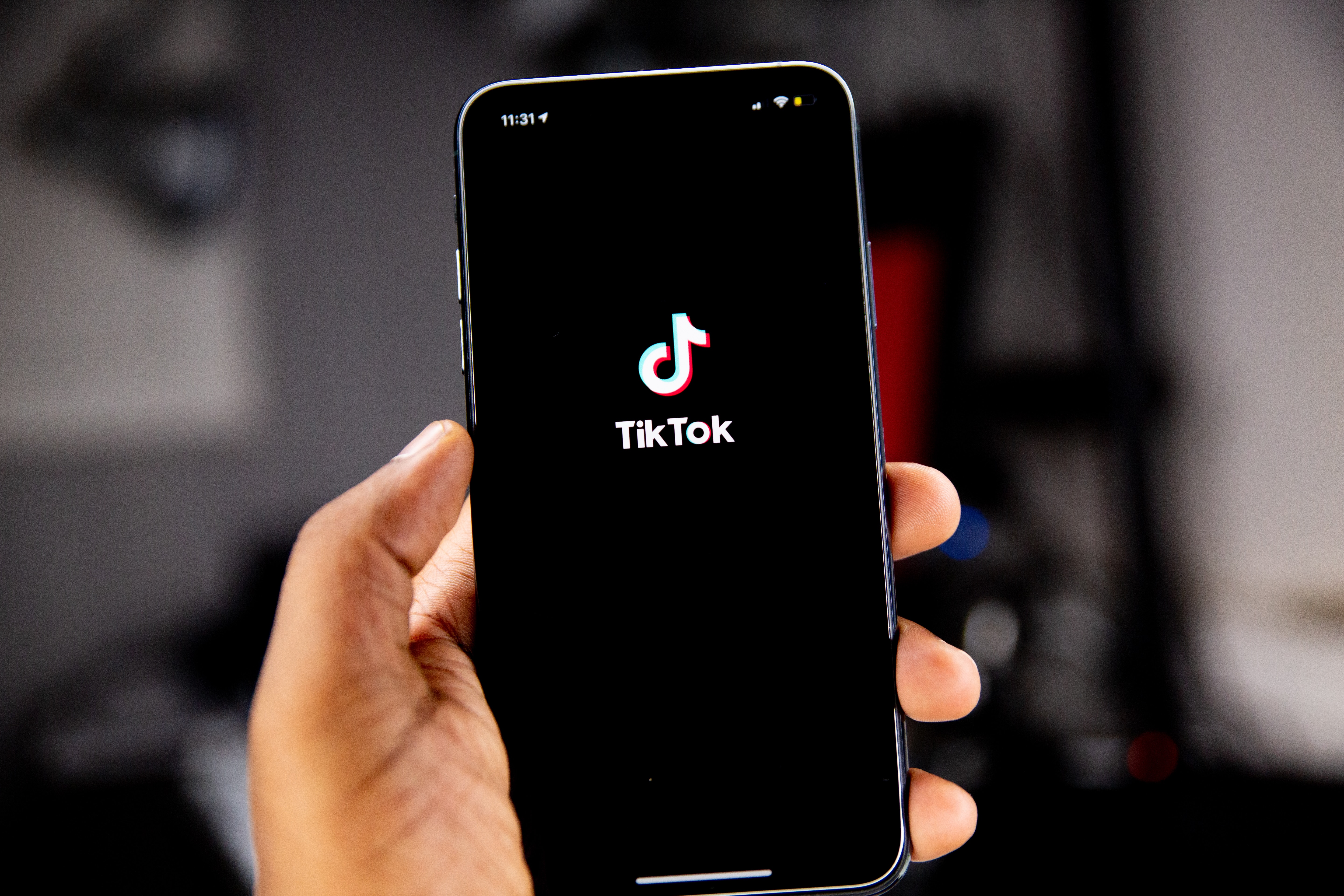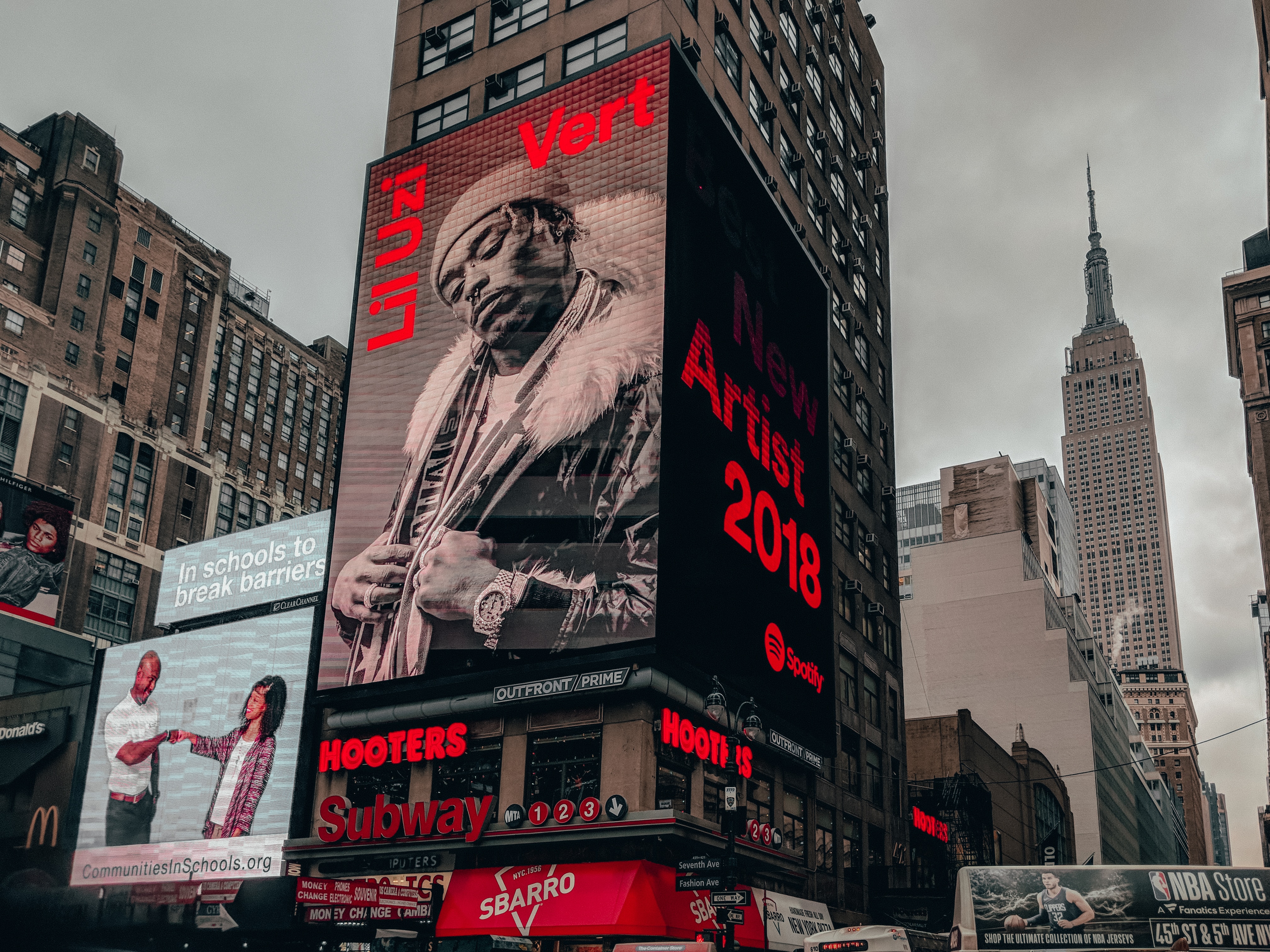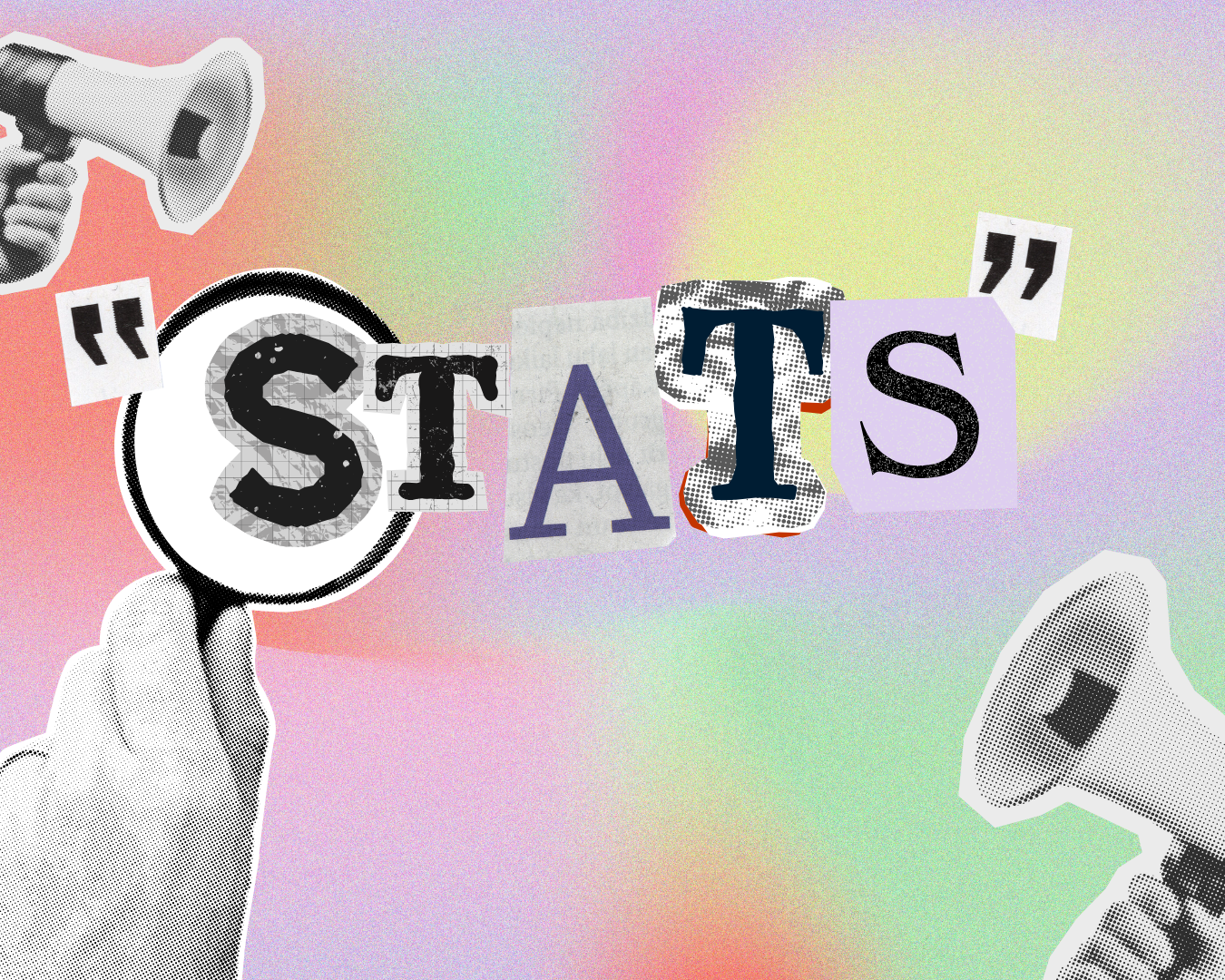
20.10.2025
LinkedIn Statistics 2025: What UK Marketers Need to Know
12 min read by Sarah Fulford-Williams
Table of Contents
Introduction
LinkedIn has evolved far beyond an online CV. In 2025 it’s a hub for networking, brand building and lead generation, particularly for B2B organisations. Yet many statistics circulating online are outdated or lack UK context. This article cuts through the noise by highlighting the most recent global and UK figures and explaining why they matter to British marketers in 2025. Whether you’re evaluating advertising budgets or refining your content strategy, these insights will help you make evidence‑based decisions.
The Global Picture: LinkedIn’s Growth and Reach
LinkedIn’s owner, Microsoft, reported that the platform generated US$17.1 billion in revenue in 2024, an 8.6 % increase from the previous year (businessofapps.com). Revenue growth reflects LinkedIn’s ability to monetise its professional user base through advertising, premium subscriptions and recruitment services. The network now boasts over one billion registered members worldwide businessofapps.com, with 70 million businesses and 160 000 schools holding accounts businessofapps.com.
LinkedIn’s advertising reach continues to expand. According to DataReportal, LinkedIn’s ads reached 1.20 billion members in January 2025 datareportal.com—up 176 million (+17.1 %) from the previous year datareportal.com. This makes LinkedIn the fifth‑largest social platform by ad reach and underscores its growing importance in the marketing mix.
Global Users by Country
LinkedIn’s largest markets remain the United States, India and China, but the UK punches above its weight. In 2024 the UK had 45 million LinkedIn members, placing it among the top five countries businessofapps.com. The table below compares user numbers in key markets.
| Country | Registered members (2024) | Notes |
|---|---|---|
| United States | 250 million | Largest LinkedIn market businessofapps.com |
| India | 150 million | Rapidly growing user base businessofapps.com |
| Brazil | 81 million | Strong adoption in Latin America businessofapps.com |
| United Kingdom | 45 million | Among top countries; high professional penetration businessofapps.com |
| France | 34 million | Established European market businessofapps.com |
These figures show that the UK represents roughly 4 % of LinkedIn’s global membership—small compared to the US but significant relative to population size. For UK brands, LinkedIn offers a concentrated pool of professionals.
UK Insights: Membership, Reach and Usage
While global figures set the scene, British marketers need locally relevant data. A Sprout Social analysis using We Are Social and Hootsuite data reports that LinkedIn had 45 million members in the UK in early 2025, reaching 64.9 % of the population sproutsocial.com. LinkedIn’s advertising tools claimed to reach 81.8 % of UK adults aged 18+ sproutsocial.com, demonstrating the platform’s ubiquity among working‑age professionals. Moreover, ad reach grew by 6 million (+15.4 %) between early 2024 and early 2025 sproutsocial.com, outpacing many competitors.
Ofcom’s Online Nation 2024 report provides additional context. It notes that LinkedIn reached 18.3 million UK adults in May 2024—about 39 % of online adults—a slight decline from 18.9 million the previous year ofcom.org.uk. Average time spent per visitor remained modest at two minutes per day ofcom.org.uk, indicating that while the platform has broad reach, users dip in and out quickly. For marketers, this means your content needs to be concise and compelling.
UK vs Global: Key Metrics
| Metric | UK | Global | Why it matters |
|---|---|---|---|
| Registered members | 45 m UK members businessofapps.com |
1+ bn global members businessofapps.com |
Highlights UK’s share of global user base |
| Ad reach | 81.8% of UK adults sproutsocial.com |
1.20 bn people worldwide datareportal.com |
Demonstrates campaign potential |
| Membership growth | +6 m (15.4%) 2024–2025 sproutsocial.com |
+176 m (17.1%) 2024–2025 datareportal.com |
Shows LinkedIn’s momentum |
| Average daily time | 2 min per visitor ofcom.org.uk |
Data not available | Suggests need for concise content |
UK brands should note the high penetration and rapid growth of LinkedIn’s ad reach. With more than four in five UK adults reachable via LinkedIn ads, the platform provides unmatched access to decision‑makers. However, short average session times mean there’s little room for fluff—your value proposition must be obvious.
Creating Content That Performs: Engagement & Best Practices
Once you understand the numbers, the next step is to maximise engagement. LinkedIn’s own research shows that completed company pages receive 30 % more weekly views sproutsocial.com. Fill out every field—including company overview, industry and contact details—and upload a professional logo and cover image. Complete profiles are more discoverable through LinkedIn’s search algorithm sproutsocial.com.
Despite the rise of short‑form video on other platforms, LinkedIn audiences still prefer text‑based posts sproutsocial.com. Static images come next, and videos perform best when kept under 15 seconds sproutsocial.com. This suggests that B2B audiences value concise insights over flashy visuals. To maximise reach:
- Post between Tuesday and Thursday, ideally around 10 a.m. when engagement peaks sproutsocial.com.
- Use a clear hook in the first line to capture attention within the feed’s limited real estate.
- Encourage conversations—posts that spark comments tend to be amplified by LinkedIn’s algorithm.
- Don’t neglect your employees; staff amplification through likes and reshares can significantly extend organic reach.
Video vs Text: Which Works Best?
| Content format | Recommended length | Engagement insight |
|---|---|---|
| Text post | N/A | Most likely to elicit comments and reactions sproutsocial.com |
| Static image | N/A | Second-best for engagement sproutsocial.com |
| Video | <15 s | Gets the most shares; keep it short sproutsocial.com |
| Long-form article | 1,800–2,100 words | Performs well for thought leadership skrapp.io |
These guidelines underline that LinkedIn users, particularly in the UK, are looking for quick, informative updates rather than lengthy sales pitches. Use videos sparingly and focus on delivering value quickly.
LinkedIn for Recruitment & B2B Marketing
LinkedIn remains a powerhouse for recruitment. The platform reports that more than 11,000 members apply for jobs every minute sproutsocial.com. Recruitment ads and job listings therefore continue to be an effective way to source talent. Interestingly, 26 % of paid job posts in 2023 didn’t require a university degree sproutsocial.com, signalling a shift towards skills‑based hiring. For employers, highlighting competencies and offering flexible pathways can broaden the talent pool.
From a marketing perspective, LinkedIn is the undisputed leader in B2B social media. Surveys cited by demand‑generation platforms (noted in our research) show that the majority of B2B marketers rate LinkedIn as their most valuable platform for lead generation. Premium subscription adoption is also rising: LinkedIn Premium saw 50 % growth over the past two years, surpassing US$2 billion in annual revenue in Q2 2025 sproutsocial.com. This suggests that users are willing to pay for enhanced networking and learning features, creating opportunities for brands to host premium‑only webinars or training sessions.
Common Misconceptions
Myth:
LinkedIn is only useful for recruitment.
Fact:
While recruitment is a core use case, LinkedIn’s ad tools and content formats make it a versatile B2B marketing platform. UK ad reach covers 81.8% of adults (Sprout Social), and posts with high engagement can reach audiences well beyond your immediate followers.
Myth:
Video content is essential on LinkedIn.
Fact:
Video can boost shares, but LinkedIn audiences still engage most with text posts and static images (Sprout Social). Focus on delivering clear insights rather than complex production.
Myth:
Only large corporates succeed on LinkedIn.
Fact:
SMEs and individuals can build authority by publishing thought-leadership articles. LinkedIn’s algorithm rewards value and engagement, not company size.
OOB’s Thoughts
Boring2Boring: Where most B2Bs go wrong on LinkedIn
Most businesses still use LinkedIn how they think they should use it, instead of asking “What do we actually want to say?” That does a disservice to your brand’s unique voice, purpose, and personality.
Common mistakes include:
- Too much corporate jargon: People want to engage with humans, not a faceless corporation.
- One-way conversation: If you’re just talking at your audience, don’t expect much back.
- No storytelling: Facts alone don’t inspire. Stories make your message stick.
- No visuals: Walls of text get scrolled past.
How to Make Your LinkedIn Content Stand Out (with examples)
Quick disclaimer: what I’ve learned in the process of finding examples for this is that there are a lot of people on LinkedIn making cool content that goes against the grain…but very few brands doing the same. And that means there’s a huge opportunity to stand out. Here’s what we think works.
1. Being Real Captures Attention
On a platform where corporate jargon is the default, realness stands out even more.
Case study example: Notpla (a sustainable startup making packaging out of seaweed!)

When Notpla’s marketing manager asked the team to post on LinkedIn, he went right by also giving them creative freedom to do it their way, resulting in this post. 120K impressions and over 1,400 reactions later, it’s safe to say it worked.
So what captured your attention first? Was it the ‘I hate LinkedIn’ standalone intro sentence, or the attached picture of the employee’s sign titled “I’m being forced to make a LinkedIn post against my will by our marketing manager”? Either way, this is a perfect example of how being real pays off.
2. Use Creative Format
A block of text isn’t going to stop someone in their tracks. But a visual (unless it’s boring) might do.
Case study example: Advertising agency OK COOL
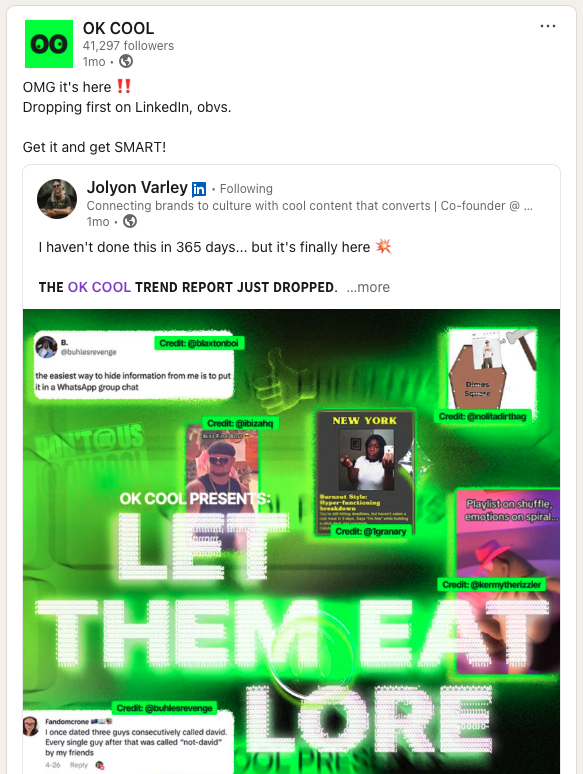
OK COOL’s LinkedIn is what it looks like to make thought leadership fun. Their voice is loud and confident, their team is involved, and their visuals tell a story that’s 100% on-brand. A lot of LinkedIn’s thought leadership will send you to sleep, but not this.
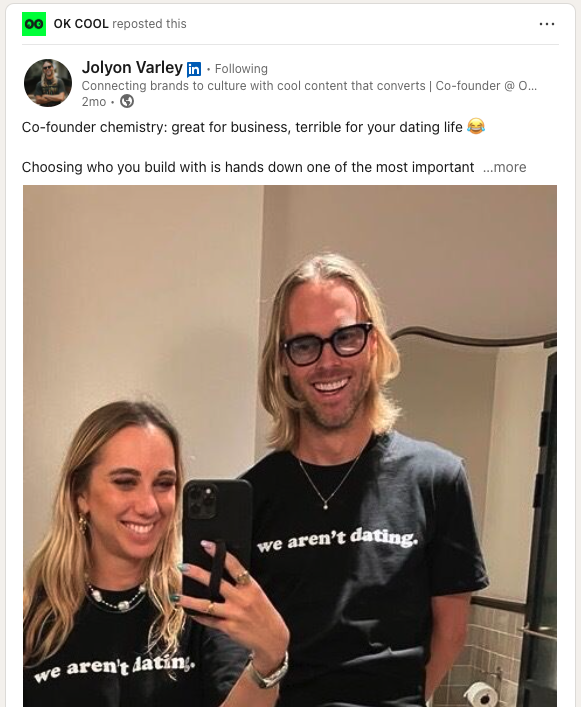
If you’re thinking, “ok cool, but we’re not a marketing agency”, this tip still applies to you! Multimedia posts are proven to outperform plain text across engagement metrics (Supergrow), with videos generating 3x more reach.
3. Know Your Brand’s Voice
Case study example: High-protein cereal brand Surreal

Take a look at Surreal’s LinkedIn and you’ll quickly see that they don’t take themselves too surreal-iously. They know their brand’s voice: cheeky, confident, laidback but also on a cereal high – and distinctly human.
This post on their OOH collab with Monzo – an unexpected partnership that works perfectly – is instantly attention-grabbing for its humour, wit, and visuals that carry the point. Surreal owned the unlikely collab with their comment: “What do banks and breakfast have in common? Not a lot tbh.” Alongside their distinct brand voice, the ad copy speaks for itself:
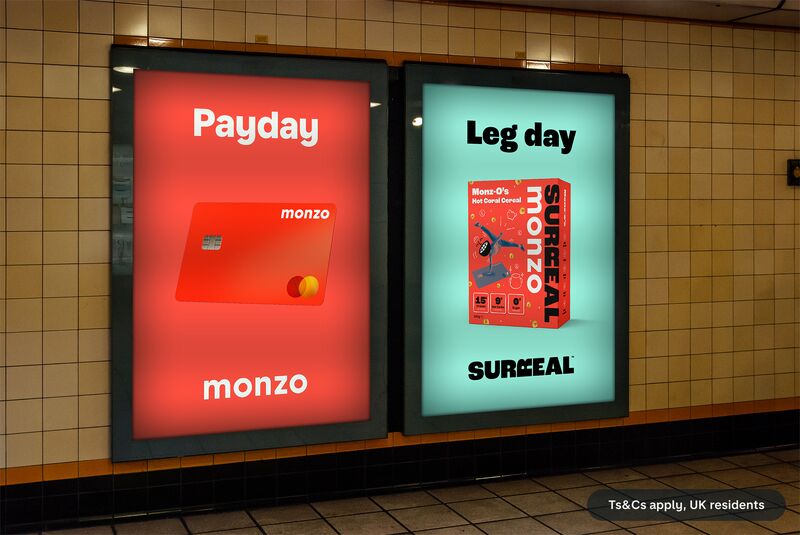
Another brilliant example is this post, where Surreal saw an opportunity to claim that celebrities, with their classic “It feels surreal” line, have been endorsing the brand for years.
“P.S. Some people will say that celebrities haven’t been endorsing us and it’s simply a coincidence. We will be ignoring those people.”
Their ‘disruptor’ brand voice is rooted in humour – something not every brand can pull off, but there’s a lot to learn from Surreal. Their dry tone is so consistent that it feels like it comes from a single person, and that human-first approach continues to earn them serious brand love.
Conclusion
LinkedIn remains the professional network of choice for UK marketers and recruiters. With 45 million UK members and ad reach covering more than four in five adults, the platform offers unparalleled access to decision‑makers. Global revenue and membership growth demonstrate that LinkedIn is far from saturated businessofapps.com. However, average session times remain short ofcom.org.uk—so keep your messaging clear, your content succinct, and your calls to action sharp.
By leveraging these up‑to‑date statistics and best practices, you can craft a LinkedIn strategy that resonates with UK audiences and drives measurable results. If you’re ready to elevate your LinkedIn presence, Our Own Brand can help.
Need help crafting your next viral campaign?
Explore our Social Media Marketing Services.
FAQs 📌
LinkedIn surpassed one billion registered members in 2024 businessofapps.com. Its advertising reach hit 1.20 billion members in January 2025 datareportal.com.
In early 2025 there were about 45 million LinkedIn members in the UK, equal to 64.9 % of the population, and LinkedIn ads reached 81.8 % of UK adults aged 18+ sproutsocial.com.
Analysis of engagement patterns shows that Tuesdays through Thursdays, particularly mid‑morning around 10 a.m., yield the highest engagement sproutsocial.com. However, you should test and refine based on your own analytics.
Yes. LinkedIn reports that pages with complete information get 30 % more weekly views sproutsocial.com. Completing your page improves discoverability and credibility.
Short videos under 15 seconds generate more engagement and shares sproutsocial.com. For B2B audiences, concise explainer clips often outperform longer formats.


